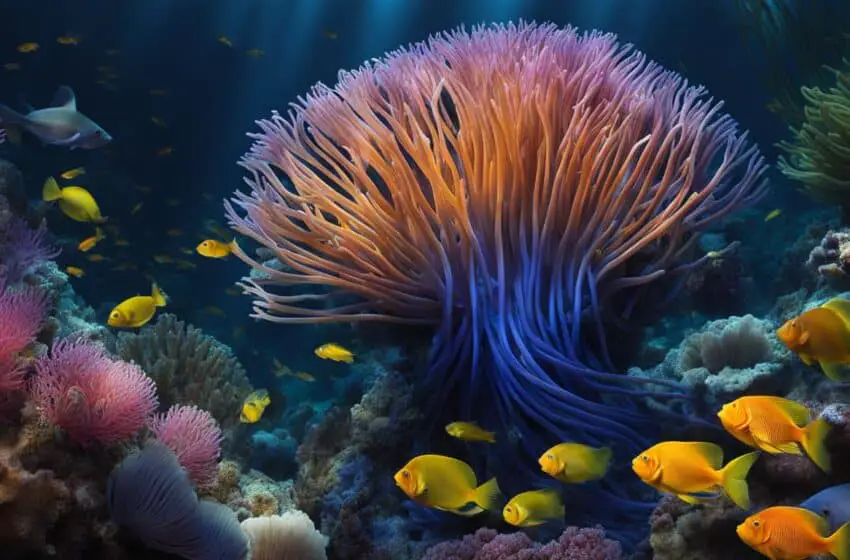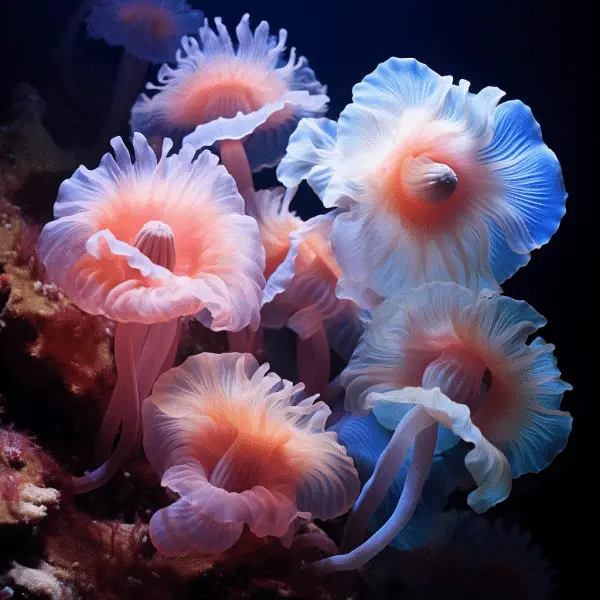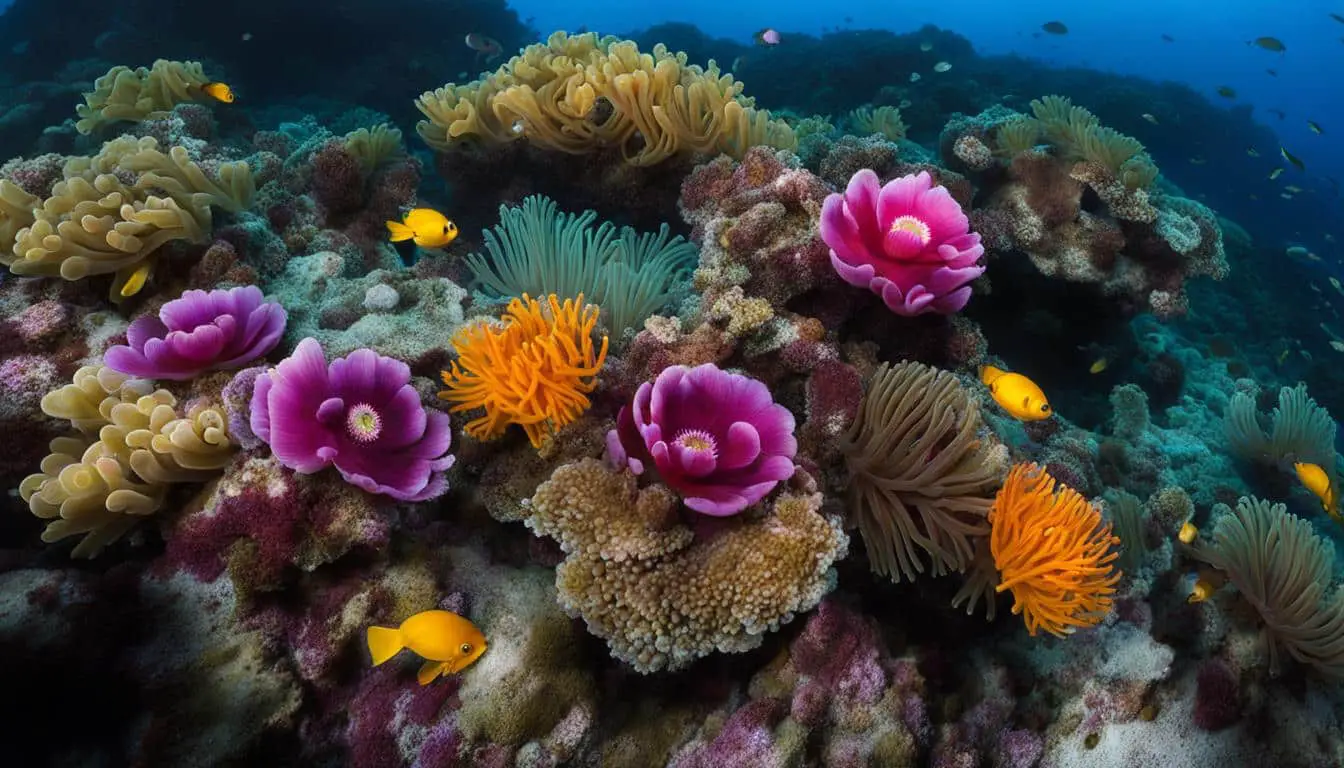Anemones: Guardians Of Ocean Biodiversity And Conservation

Welcome to my latest article, where we dive into the fascinating world of anemones and their significance in oceanography research. As marine invertebrates, anemones hold a crucial place in deep-sea ecosystems, contributing to the delicate balance of life beneath the waves.
Anemones In Ocean Biodiversity And Conservation, particularly cnidarians like corals, have formed a unique symbiotic relationship with algae, allowing them to thrive in nutrient-poor environments. Traditionally, the focus of oceanic nutrient research has centered on understanding the role of algae, especially in nitrogen recycling. However, recent studies conducted by a group of scientists from KAUST have challenged this belief by revealing the active involvement of anemones in nitrogen assimilation and recycling processes.
Through advanced techniques like laser microdissection and single-cell RNA-sequencing, these scientists discovered that anemones play a significant role in nitrogen recycling, previously attributed solely to algae. This newfound understanding opens doors for the development of selective breeding methods and conservation efforts aimed at protecting the intricate web of life found in reef ecosystems.
Key Takeaways:
- Anemones, as marine invertebrates, have a vital role in deep-sea ecosystems.
- They form symbiotic relationships with algae, enabling them to survive in nutrient-poor environments.
- Recent research challenges the traditional belief that only algae are responsible for nitrogen recycling in their relationship.
- Anemones’ active involvement in nitrogen assimilation and recycling can contribute to the development of selective breeding methods and conservation efforts.
The Role of Anemones in Maintaining Biodiversity and Ecological Interactions

Anemones are essential to marine biodiversity. These intriguing organisms inhabit many ocean habitats. Their ability to create symbiotic connections with fish and crustaceans helps to the diverse ocean ecosystem.
“Anemones provide shelter and protection for clownfish, while receiving food scraps and protection against predators in return.”
“Anemones act as habitat providers for a variety of invertebrates, contributing to the overall biodiversity of their surroundings.”
Some anemone species hide and protect clownfish in exchange for food scraps and predator protection. This mutually beneficial relationship protects both species. In addition, anemones provide habitat for many invertebrates, increasing biodiversity.
These anemone-related biological interactions maintain marine ecosystem balance. They form complex feeding chains and help many species survive, maintaining the delicate balance of our waters.
The Distribution of Anemone Species
The species distribution of anemones is extensive, with different species occupying specific ecological niches. Some anemones thrive in shallow, coastal waters, while others are found in deeper regions of the ocean. Their distribution is influenced by factors such as temperature, water currents, and availability of suitable substrates for attachment.
Anemone species distribution patterns have been studied by conducting comprehensive surveys and collecting abundance data. This data is essential for marine ecosystem health and diversity assessments. Anemone species distribution maps allow researchers to identify biodiversity hotspots and focus conservation efforts to safeguard fragile environments.
The Importance of Anemones in Biodiversity Conservation
Marine environments with anemones are healthy and diversified. Anemones’ habitat and ecological interactions demonstrate their importance to biodiversity. We can protect marine ecosystems for future generations by protecting Anemones In Ocean Biodiversity And Conservations and its species.
| Anemone Species | Habitat | Distribution |
|---|---|---|
| Metridium senile | Rocky shores | North Atlantic, North Pacific |
| Anthopleura elegantissima | Tide pools, intertidal zones | West coast of North America |
| Entacmaea quadricolor | Coral reefs | Tropical oceans worldwide |
| Actinia equina | Sandy seabeds, estuaries | North Atlantic, North Pacific |
Table: Examples of Anemone Species and their Habitat Distribution
Understanding the ecological role of anemones and their significance in maintaining biodiversity is crucial for implementing effective conservation strategies. By protecting these remarkable creatures and the ecosystems they inhabit, we can contribute to the preservation of our oceans’ health and resilience.
Anemone Adaptation to Ocean Conditions and Conservation Efforts
Given their ability to survive in varying ocean environments, anemones have developed many adaptations to prosper in their surroundings. These adaptations help marine ecosystems regulate and survive environmental stress. For effective conservation of anemones and their sensitive ecosystems, oceanographers must understand their behavior and adaptability mechanisms.
Anemones retract their tentacles during low tide to avoid drying out then extend them to feed on food. Energy conservation and water level adaptation are achieved by this behavior. Anemones can release or keep symbiotic algae depending on energy needs. This versatility lets them survive limited food supply and maintain a balanced mutualistic relationship with their symbiotic partners.
Despite their resilience, Anemones In Ocean Biodiversity And Conservation are vulnerable to pollution and rising ocean temperatures. These things can harm their sensitive ecosystems and survival. Conservation is essential to protect anemones and their ecosystem functions. Oceanographers can design successful conservation strategies for anemones in varied maritime settings by analyzing their behavior and adaptive mechanisms.
Anemone Conservation Efforts
Conservation efforts for anemones focus on preserving their habitats, mitigating pollution, and addressing the impacts of climate change. Establishing marine protected areas and implementing sustainable fishing practices help protect the ecosystems where anemones reside. These measures ensure the preservation of anemones and the diverse array of species that rely on their presence.
Additionally, raising awareness about the importance of anemones and their ecological role is crucial for garnering support for conservation initiatives. The general public, policymakers, and stakeholders need to understand the value of anemones in maintaining the health and resilience of marine ecosystems. By working together, we can create a sustainable future for anemones and the oceans they inhabit.

Table: Threats to Anemone Conservation
| Threat | Description |
|---|---|
| Pollution | Chemical and plastic pollution can harm anemones, affecting their ability to survive and reproduce. |
| Climate Change | Rising ocean temperatures and ocean acidification pose significant threats to anemones and their symbiotic partners. |
| Habitat Destruction | Destructive fishing practices, coastal development, and coral bleaching can lead to the loss of anemone habitats. |
| Overexploitation | Illegal collection and trade of anemones for the aquarium trade can deplete wild populations. |
Understanding the threats to Anemones In Ocean Biodiversity And Conservation is essential for developing targeted strategies to mitigate these risks. By addressing these challenges and implementing effective conservation measures, we can ensure the long-term survival of anemones and the preservation of the invaluable ecosystems they contribute to.
Conclusion
The research conducted on anemones in oceanography has provided invaluable insights into the critical role these marine invertebrates play in deep-sea ecosystems. By exploring their symbiotic relationships, anemones have been found to contribute significantly to the biodiversity and ecological interactions within our oceans.
From their wide distribution across different regions to their ability to form symbiotic partnerships with various organisms, Anemones In Ocean Biodiversity And Conservation, anemones have proven to be essential for maintaining the delicate balance and health of marine ecosystems. These interactions, such as providing shelter and protection for clownfish, demonstrate the intricate web of relationships that exist beneath the ocean’s surface.
Anemones have also adapted to survive in diverse ocean conditions, showcasing their remarkable behavior. Their flexibility, such as retracting their tentacles during low tide, allows them to endure challenging circumstances. However, these fascinating creatures are not without vulnerability. Increased ocean temperatures and pollution pose significant threats to their existence.
Therefore, conservation efforts are crucial to safeguard anemones and the valuable ecosystems they contribute to. By studying their behavior, adaptation mechanisms, and understanding their ecological role, scientists can develop effective strategies to protect these remarkable creatures. Continued research and conservation efforts are essential to ensure the health, resilience, and preservation of our oceans for future generations.
FAQ
What is the role of anemones in marine ecosystems?
Anemones play a crucial role in maintaining biodiversity and ecological interactions in marine ecosystems. They act as habitat providers for various invertebrates and form symbiotic relationships with other organisms, contributing to the overall balance and health of the ecosystem.
How do anemones adapt to different ocean conditions?
Anemones have evolved various adaptations to survive in different ocean conditions. They exhibit behaviors such as retracting their tentacles during low tide to avoid drying out and extending them to feed when prey is available. They can also release or retain their symbiotic algae depending on their energy needs, allowing them to withstand periods of low food availability.
What are the conservation efforts for protecting anemones?
Anemones are vulnerable to environmental stresses such as pollution and increased ocean temperatures. Conservation efforts are crucial to protect these organisms and the valuable ecosystems they contribute to. By understanding their adaptation mechanisms and developing conservation strategies, we can ensure their survival in the face of ongoing environmental changes.
Source Links
- https://news.uci.edu/2020/12/09/sea-anemones-find-sweet-arrangement-with-under-skin-algae-for-emergency-food-source/
- https://www.newswise.com/articles/sea-anemones-aid-thriving-reef-ecosystems-with-sweet-contributions
- https://www.bio.uci.edu/sea-anemones-find-sweet-arrangement-with-under-skin-algae-for-emergency-food/



